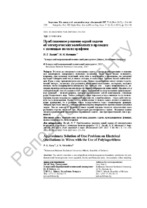| dc.contributor.author | Ласый, П. Г. | ru |
| dc.contributor.author | Мелешко, И. Н. | ru |
| dc.coverage.spatial | Минск | ru |
| dc.date.accessioned | 2017-07-06T17:59:31Z | |
| dc.date.available | 2017-07-06T17:59:31Z | |
| dc.date.issued | 2017 | |
| dc.identifier.citation | Ласый, П. Г., Мелешко И. Н. Приближенное решение одной задачи об электрических колебаниях в проводах с помощью полилогарифмов = Approximate Solution of One Problem on Electrical Oscillations in Wires with the Use of Polylogarithms / П. Г. Ласый, И. Н. Мелешко // Энергетика. Известия высших учебных заведений и энергетических объединений СНГ. – 2017. – № 4. – С. 334-340. | ru |
| dc.identifier.uri | https://rep.bntu.by/handle/data/31601 | |
| dc.description.abstract | В статье рассматривается смешанная задача с однородными краевыми условиями для одномерного однородного волнового уравнения. Такая задача может возникнуть, например, при изучении колебаний силы тока и напряжения в проводнике, по которому проходит электрический ток, и линия свободна от искажения. Решение можно найти методом Фурье в виде тригонометрического ряда. Данное представление имеет только теоретический интерес, поскольку для реального вычисления необходимо, во-первых, находить большое число коэффициентов-интегралов, что само по себе – задача нетривиальная и, во-вторых, практически невозможно провести оценку погрешности вычислений. Предлагается альтернативный способ решения этой задачи, основанный на использовании трансцендентных функций – полилогарифмов, которые представляют собой комплексные степенные ряды специального вида. Точное решение задачи выражается через мнимую часть полилогарифма первого порядка на единичной окружности, а приближенное – через действительную часть дилогарифма. Кроме того, если начальные условия в задаче являются элементарными функциями, то и решение также осуществляется через элементарные функции. Найдена простая и вместе с тем эффективная оценка погрешности приближенного решения задачи. Она не зависит от времени и имеет первый порядок точности относительно шага разбиения отрезка числовой оси, на котором рассматривается задача. Указанная оценка является равномерной относительно переменных задачи – как пространственной, так и временнóй. | ru |
| dc.language.iso | ru | ru |
| dc.publisher | БНТУ | ru |
| dc.subject | Electric oscillations | en |
| dc.subject | Solution of the problem | en |
| dc.subject | Transcendental functions | en |
| dc.subject | Error estimate | en |
| dc.subject | Polylogarithm | en |
| dc.subject | Электрические колебания | ru |
| dc.subject | Решение задачи | ru |
| dc.subject | Трансцендентные функции | ru |
| dc.subject | Оценка погрешности | ru |
| dc.subject | Полилогарифм | ru |
| dc.title | Приближенное решение одной задачи об электрических колебаниях в проводах с помощью полилогарифмов | ru |
| dc.title.alternative | Approximate Solution of One Problem on Electrical Oscillations in Wires with the Use of Polylogarithms | en |
| dc.type | Article | ru |
| dc.relation.journal | Известия высших учебных заведений и энергетических объединений СНГ. Энергетика | ru |
| dc.identifier.doi | 10.21122/1029-7448-2017-60-4-334-340 | |
| local.description.annotation | The article considers a mixed problem with homogeneous boundary conditions for one-dimensional homogeneous wave equation. Such a problem can arise, for example, when studying oscillations of current and voltage in the conductor through which electric current flows, while the line is free from distortion. The solution can be found with the use of the Fourier method in the form of trigonometric series. This representation is of purely theoretical interest, because the real calculation should be, first, to find a large number of coefficients of the integrals, which in itself is not a trivial task and, second, it is almost impossible to assess the error of the calculations. An alternative way of solving this problem based on the use of transcendental functions i. e. polylogarithms that represent complex power series of a special kind. The exact solution of the problem is expressed through the imaginary part of a polylogarithm of the first order on the single circle and the approximate one – via the real part of the dilogarithm. In addition, if the initial conditions in the problem are elementary functions, then the solution is also computed using elementary functions. A simple and effective error estimate of the approximate solution has been found. It does not depend on time and it has the first-order of accuracy regarding the step of a partitioning segment of the numerical axis on which the problem is considered. This valuation is uniform with respect to the variables of the problem – both spatial and temporal. | en |

